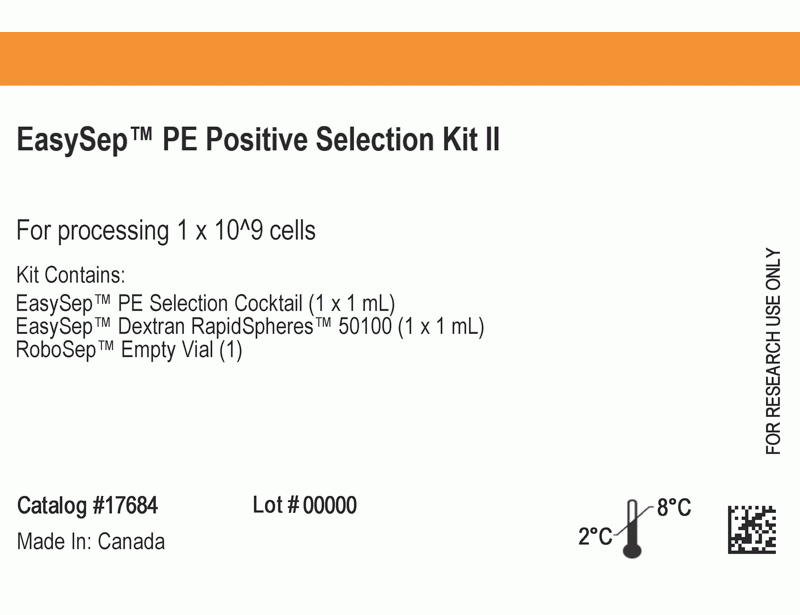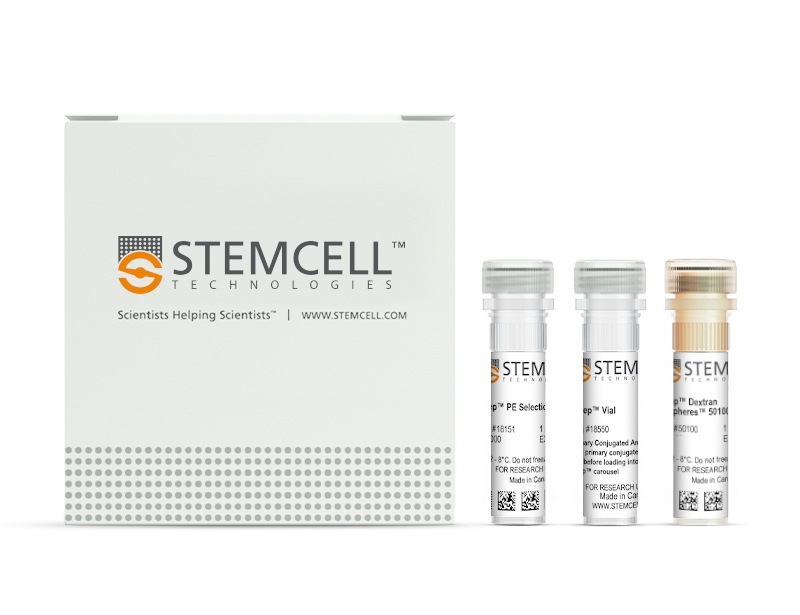概要
The EasySep™ PE Positive Selection Kit II is designed to isolate cells that are labeled with PE-conjugated antibodies. Desired cells are targeted with antibody complexes recognizing PE and dextran-coated magnetic particles. Labeled cells are separated using an EasySep™ magnet without the use of columns. Cells of interest remain in the tube while unwanted cells are poured off.
This product replaces the EasySep™ PE Positive Selection Kit (Catalog #18557) for even faster cell isolations.
This product replaces the EasySep™ PE Positive Selection Kit (Catalog #18557) for even faster cell isolations.
技术资料
| Document Type | 产品名称 | Catalog # | Lot # | 语言 |
|---|---|---|---|---|
| Product Information Sheet | EasySep™ PE Positive Selection Kit II | 17684 | All | English |
| Product Information Sheet | RoboSep™ PE Positive Selection Kit II | 17684RF | All | English |
| Safety Data Sheet 1 | EasySep™ PE Positive Selection Kit II | 17684 | All | English |
| Safety Data Sheet 2 | EasySep™ PE Positive Selection Kit II | 17684 | All | English |
| Safety Data Sheet 3 | EasySep™ PE Positive Selection Kit II | 17684 | All | English |
| Safety Data Sheet 1 | RoboSep™ PE Positive Selection Kit II | 17684RF | All | English |
| Safety Data Sheet 2 | RoboSep™ PE Positive Selection Kit II | 17684RF | All | English |
| Safety Data Sheet 3 | RoboSep™ PE Positive Selection Kit II | 17684RF | All | English |
数据及文献
Publications (3)
Blood 2020 jan
Myeloid cell-targeted miR-146a mimic inhibits NF-$\kappa$B-driven inflammation and leukemia progression in vivo.
Abstract
Abstract
NF-$\kappa$B is a key regulator of inflammation and cancer progression, with an important role in leukemogenesis. Despite its therapeutic potential, targeting NF-$\kappa$B using pharmacologic inhibitors has proven challenging. Here, we describe a myeloid cell-selective NF-$\kappa$B inhibitor using an miR-146a mimic oligonucleotide conjugated to a scavenger receptor/Toll-like receptor 9 agonist (C-miR146a). Unlike an unconjugated miR146a, C-miR146a was rapidly internalized and delivered to the cytoplasm of target myeloid cells and leukemic cells. C-miR146a reduced expression of classic miR-146a targets (IRAK1 and TRAF6), thereby blocking activation of NF-$\kappa$B in target cells. IV injections of C-miR146a mimic to miR-146a-deficient mice prevented excessive NF-$\kappa$B activation in myeloid cells, and thus alleviated myeloproliferation and mice hypersensitivity to bacterial challenge. Importantly, C-miR146a showed efficacy in dampening severe inflammation in clinically relevant models of chimeric antigen receptor (CAR) T-cell-induced cytokine release syndrome. Systemic administration of C-miR146a oligonucleotide alleviated human monocyte-dependent release of IL-1 and IL-6 in a xenotransplanted B-cell lymphoma model without affecting CD19-specific CAR T-cell antitumor activity. Beyond anti-inflammatory functions, miR-146a is a known tumor suppressor commonly deleted or expressed at reduced levels in human myeloid leukemia. Using The Cancer Genome Atlas acute myeloid leukemia data set, we found an inverse correlation of miR-146a levels with NF-$\kappa$B-related genes and with patient survival. Correspondingly, C-miR146a induced cytotoxic effects in human MDSL, HL-60, and MV4-11 leukemia cells in vitro. The repeated IV administration of C-miR146a inhibited expression of NF-$\kappa$B target genes and thereby thwarted progression of disseminated HL-60 leukemia. Our results show the potential of using myeloid cell-targeted miR-146a mimics for the treatment of inflammatory and myeloproliferative disorders.
Frontiers in immunology 2020
Intestinal Macrophages Balance Inflammatory Expression Profiles via Vitamin A and Dectin-1-Mediated Signaling.
Abstract
Abstract
Tissue resident intestinal macrophages are known to exhibit an anti-inflammatory phenotype and produce little pro-inflammatory cytokines upon TLR ligation, allowing symbiotic co-existence with the intestinal microbiota. However, upon acute events such as epithelial damage and concomitant influx of microbes, these macrophages must be able to quickly mount a pro-inflammatory response while more inflammatory macrophages are recruited from the blood stream simultaneously. Here, we show that dietary intake of vitamin A is required for the maintenance of the anti-inflammatory state of tissue resident intestinal macrophages. Interestingly, these anti-inflammatory macrophages were characterized by high levels of Dectin-1 expression. We show that Dectin-1 expression is enhanced by the vitamin A metabolite retinoic acid and our data suggests that Dectin-1 triggering might provide a switch to induce a rapid production of pro-inflammatory cytokines. In addition, Dectin-1 stimulation resulted in an altered metabolic profile which is linked to a pro-inflammatory response. Together, our data suggests that presence of vitamin A in the small intestine enhances an anti-inflammatory phenotype as well as Dectin-1 expression by macrophages and that this anti-inflammatory phenotype can rapidly convert toward a pro-inflammatory state upon Dectin-1 signaling.
Nature microbiology 2019 feb
HIV-1 reservoirs in urethral macrophages of patients under suppressive antiretroviral therapy.
Abstract
Abstract
Human immunodeficiency virus type 1 (HIV-1) eradication is prevented by the establishment on infection of cellular HIV-1 reservoirs that are not fully characterized, especially in genital mucosal tissues (the main HIV-1 entry portal on sexual transmission). Here, we show, using penile tissues from HIV-1-infected individuals under suppressive combination antiretroviral therapy, that urethral macrophages contain integrated HIV-1 DNA, RNA, proteins and intact virions in virus-containing compartment-like structures, whereas viral components remain undetectable in urethral T cells. Moreover, urethral cells specifically release replication-competent infectious HIV-1 following reactivation with the macrophage activator lipopolysaccharide, while the T-cell activator phytohaemagglutinin is ineffective. HIV-1 urethral reservoirs localize preferentially in a subset of polarized macrophages that highly expresses the interleukin-1 receptor, CD206 and interleukin-4 receptor, but not CD163. To our knowledge, these results are the first evidence that human urethral tissue macrophages constitute a principal HIV-1 reservoir. Such findings are determinant for therapeutic strategies aimed at HIV-1 eradication.

 网站首页
网站首页




